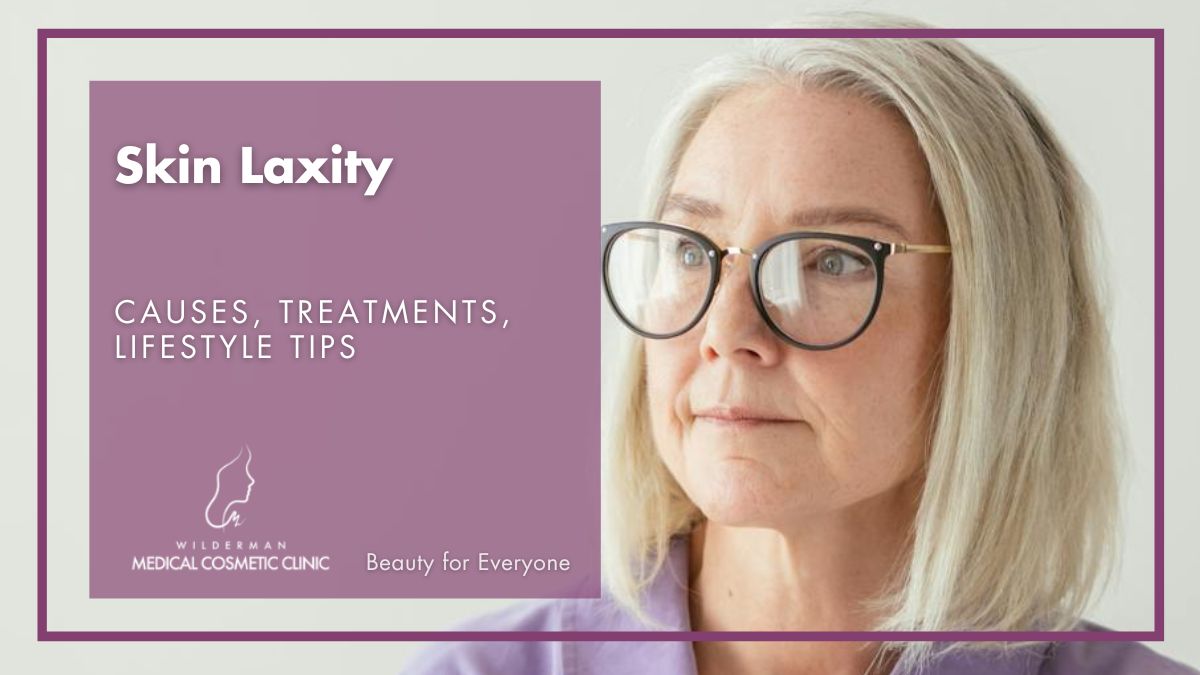Skin Laxity
A common skin concern
Skin laxity is a common concern that many individuals experience as they age.
It is characterized by a loss of firmness, elasticity, and resilience in the skin, leading to a less youthful appearance.

Get immediate answers about possible treatment options tailored for you, expected results, and much more.
- Expert Diagnosis
- Customized Treatment Plans
- No Obligation
- Comfort and Privacy
- Immediate Answers
Skin laxity can affect various areas of the body, including the face, neck, arms, abdomen, and thighs. Skin laxity contributes to skin sagging as the skin loses its elasticity and becomes less able to maintain its natural position against the effects of gravity.
In this article, we will delve into the causes of skin laxity, the role of collagen and elastin, recommended skincare products, and various treatments available to improve skin laxity.
Causes of Skin Laxity
- Natural Aging Process: As we age, the production of collagen and elastin proteins, which are responsible for maintaining the skin’s firmness and elasticity, decreases. This leads to a loss of skin support and resilience, resulting in sagging and laxity.
- Sun Damage: Prolonged exposure to ultraviolet (UV) radiation from the sun can accelerate the breakdown of collagen and elastin fibers in the skin. This can lead to a reduction in skin elasticity and contribute to the development of skin laxity.
- Lifestyle Factors: Unhealthy lifestyle choices, such as smoking, excessive alcohol consumption, poor nutrition, and lack of exercise, can accelerate the aging process and negatively impact the skin’s elasticity. These habits can compromise collagen production and contribute to skin laxity.
It’s important to note that these factors can interact and vary in intensity for each individual, resulting in differences in the degree of skin laxity experienced. Additionally, environmental factors, stress, and overall health can also play a role in the development of skin laxity.
What are Collagen and Elastin?
Collagen and elastin are vital proteins that play crucial roles in maintaining the health and appearance of the skin.
- Collagen: Collagen is the most abundant protein in the body and acts as the building block for the skin’s structure. It provides strength, support, and firmness to the skin. Collagen fibers form a network that gives the skin its structural integrity, preventing it from sagging and maintaining its smoothness. It helps to maintain a youthful appearance by promoting skin elasticity and reducing the appearance of wrinkles and fine lines.
- Elastin: Elastin, as the name suggests, is responsible for the skin’s elasticity. It allows the skin to stretch and then return to its original shape, helping it maintain its tautness and resilience. Elastin fibers are highly flexible and can recoil after being stretched, enabling the skin to retain its tightness and prevent sagging. Elastin works in conjunction with collagen to provide the skin with the ability to bounce back and maintain its youthful appearance.
The Decline of Collagen and Elastin with Age
The production of collagen and elastin naturally declines with age. Several factors contribute to this decline:
- Genetic Factors: The genetic makeup of an individual can influence the production and quality of collagen and elastin in the skin. Some people may have genetically determined variations in their collagen and elastin structure, making them more prone to skin laxity and premature aging.
- Hormonal Changes: Hormonal fluctuations, particularly during menopause in women, can lead to a decrease in collagen production. Estrogen, a hormone that helps maintain skin elasticity, declines with age, resulting in reduced collagen synthesis and increased skin laxity.
- Environmental Influences: External factors such as sun exposure, pollution, and lifestyle habits like smoking and poor nutrition can accelerate the breakdown of collagen and elastin fibers. UV radiation from the sun is particularly damaging, as it can cause the production of harmful enzymes that degrade collagen and elastin.
The decline in collagen and elastin levels contributes to the loss of skin elasticity, firmness, and resilience. The skin becomes more prone to sagging, wrinkles, and fine lines.
To counteract this decline, various treatments and skincare practices aim to stimulate collagen and elastin production or provide external support to improve skin laxity and maintain a youthful appearance.
Skincare Products for Skin Laxity
While skincare products cannot completely reverse skin laxity, they can help improve the appearance and texture of the skin. Look for products that contain the following ingredients:
- Retinoids: Retinoids, such as retinol and tretinoin, can stimulate collagen production and help reduce the appearance of fine lines and wrinkles.
- Antioxidants: Antioxidants like vitamin C, vitamin E, and green tea extract protect the skin from free radicals and promote collagen synthesis.
- Peptides: Peptides are small proteins that can help support collagen production and improve skin elasticity.
- Moisturizers: Hydrated skin appears plumper and healthier, so regular moisturizing can temporarily improve the appearance of skin laxity.
Professional Treatments for Skin Laxity
For more significant improvement in skin laxity, various professional treatments are available. Two popular options are Ultherapy and Morpheus8:
Ultherapy: Ultherapy is a non-invasive procedure that uses ultrasound technology to stimulate collagen production deep within the skin. It targets the foundational layers, resulting in firmer, tighter skin over time. One of the key advantages of Ultherapy is its ability to target specific depths, ensuring that the energy is delivered precisely to the areas where it can have the most impact. This precision allows for a customized treatment approach tailored to individual needs, focusing on areas of concern such as the face, neck, and décolletage. Ultherapy is a popular choice for individuals seeking non-surgical alternatives to address mild to moderate skin laxity, as it provides noticeable results without the need for incisions, downtime, or significant discomfort.
Morpheus8: What sets Morpheus8 apart is its integration of RF energy, which is delivered through microneedles into the deeper layers of the skin. The RF energy generates heat, further stimulating collagen production and promoting skin tightening. This dual-action approach of microneedling and RF energy makes Morpheus8 highly effective in improving skin laxity, reducing wrinkles, and refining skin texture. Morpheus8’s customizable settings allow for precise treatment depth and intensity, catering to individual skin concerns and goals. The treatment is typically well-tolerated, as numbing cream is applied prior to the procedure to enhance comfort.
Other treatments that can be effective in improving skin laxity include:
Microneedling: Microneedling is a minimally invasive procedure that helps improve skin laxity. It involves using a device with tiny needles to create controlled micro-injuries on the skin. This stimulates collagen and elastin production, leading to tighter, firmer skin.
Dermal Fillers: Injecting dermal fillers can temporarily plump up sagging skin and restore volume, reducing the appearance of skin laxity.
Radiofrequency (RF) Skin Tightening: RF treatments use energy waves to heat the deep layers of the skin, stimulating collagen production and promoting skin tightening. This can help improve skin laxity and firmness.
Laser Treatments: Laser therapies can target specific areas of the skin to stimulate collagen production and tighten loose skin. They can be effective for treating mild to moderate skin laxity.
Chemical Peels: Chemical peels involve the application of a chemical solution to exfoliate the outer layers of the skin. This process promotes collagen production, improves skin texture, and can help tighten mild skin laxity.
Microcurrent Therapy: Microcurrent treatments use low-level electrical currents to stimulate facial muscles, improving muscle tone and lifting sagging skin. This can help reduce the appearance of skin laxity and promote a more youthful look.
Thread Lift: A thread lift is a minimally invasive procedure that involves inserting dissolvable sutures into the skin to lift and tighten sagging areas. This technique stimulates collagen production and provides immediate lifting effects.
Lifestyle Modifications
In addition to professional treatments and skincare products, certain lifestyle modifications can support the improvement of skin laxity:
- Protect your skin from excessive sun exposure by wearing sunscreen, seeking shade, and wearing protective clothing.
- Maintain a healthy diet rich in fruits, vegetables, lean proteins, and omega-3 fatty acids to support overall skin health.
- Stay hydrated by drinking an adequate amount of water daily.
- Avoid smoking and limit alcohol consumption, as they can contribute to skin damage and accelerate the aging process.
- Practice a consistent skincare routine that includes gentle cleansing, exfoliation, and moisturizing to keep the skin nourished and hydrated.
Take Away
While it is not possible to completely reverse skin laxity, combining effective skincare products, professional treatments, and healthy lifestyle choices can significantly improve the appearance and texture of the skin, promoting a more youthful and firm complexion.
Consulting with an aesthetic physician or skincare professional can help determine the most suitable treatment options for individual needs and goals.
Reference
Artisan Skin and Laser. Skin Laxity: What Causes It & How Can We Treat It? Retrieved from https://artisanskinandlaser.com/blog/skin-laxity-what-causes-it-how-can-we-treat-it. Accessed on May 16, 2023.
APT Medical Aesthetics. Skin Laxity. Retrieved from https://www.aptmedicalaesthetics.com/conditions/skin-laxity/. Accessed on May 16, 2023.
Cosmetic & Plastic Surgery Specialists. Skin Laxity. Retrieved from https://cosmeticplastics.com/medical-spa/skin-laxity/. Accessed on May 16, 2023.
Other skin conditions that may be of interest
Marionette Lines – Marionette lines, sometimes referred to as puppet lines, are facial wrinkles that form vertically from the corners of the mouth downward toward the chin. These lines can give the appearance of a …
Sagging Skin – As we age, one of the most common concerns we face is sagging skin. The loss of elasticity and firmness can affect various parts of our body, including the face, neck, arms, and abdomen. Sagging skin can be attributed to …
Stretch Marks: Causes, Treatments, Prevention – Stretch marks, also known as striae, are a common skin condition that affects both men and women. They often appear as visible lines on the skin, typically on …
Spider Veins and Broken Capillaries – Spider veins and broken capillaries are common vascular conditions that affect a significant number of people. While they are typically harmless, they can cause cosmetic concerns for …
Oily Skin – Oily skin is a common dermatological condition characterized by excess sebum production, which can lead to a shiny, greasy appearance and potential skin issues such as acne breakouts and clogged pores. While it can be …
Smoker’s lines: A real connection to smoking? – Smoker’s lines, also known as lip lines, lipstick lines, or perioral wrinkles, are fine lines that develop around the mouth and lips. These lines can be unsightly and may contribute to …
Acne Scarring: Causes, Treatment, Prevention – Acne is a common skin condition that affects millions of people worldwide, causing physical and emotional distress. In some cases, acne can leave behind unsightly scars, further impacting …
Dark Under-Eye Circles – Dark under-eye circles can be frustrating and make you appear tired or older than you actually are. They are a common cosmetic concern that affects people of all ages. We will explore what …
Stay Ahead of the Beauty Curve
Beyond Beauty: Elevate Your Routine with Insider Tips and Breakthroughs – Subscribe Now!
Transform your beauty routine into something extraordinary!


